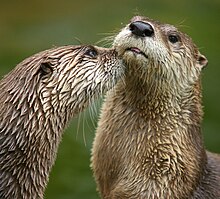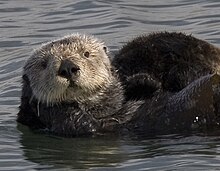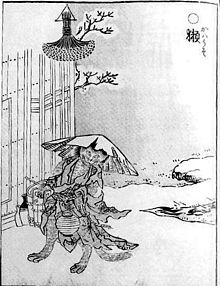Etymology
The word otter derives from the Old English word otor or oter. This, and cognate words in other Indo-European languages, ultimately stem from the Proto-Indo-European language root *wódr̥, which also gave rise to the English word "water".[4][5]Terminology
An otter's den is called a holt or couch. Male otters are called dogs or boars, females are called bitches or sows, and their offspring are called pups.[6] The collective nouns for otters are bevy, family, lodge, romp (being descriptive of their often playful nature) or, when in water, raft.[7][8]The feces of otters are typically identified by their distinctive aroma, the smell of which has been described as ranging from freshly mown hay to putrefied fish;[9] these are known as spraints.[10]
Life cycle
The gestation period in otters is about 60 to 86 days. The newborn pup is cared for by the bitch, dog and older offspring. Bitch otters reach sexual maturity at approximately two years of age and males at approximately three years. The holt is built under tree roots or a rocky cairn, more common in Scotland. It is lined with moss and grass.After one month, the pup can leave the holt and after two months, it is able to swim. The pup lives with its family for approximately one year. Otters live up to 16 years; they are by nature playful, and frolic in the water with their pups. Its usual source of food is fish, and further downriver, eels, but it may sample frogs and birds.
Characteristics
Otters have long, slim bodies and relatively short limbs. Their most striking anatomical features are the powerful webbed feet used to swim, and their seal-like abilities holding breath underwater. Most have sharp claws on their feet and all except the sea otter have long, muscular tails. The 13 species range in adult size from 0.6 to 1.8 m (2.0 to 5.9 ft) in length and 1 to 45 kg (2.2 to 99.2 lb) in weight. The Asian small-clawed otter is the smallest otter species and the giant otter and sea otter are the largest. They have very soft, insulated underfur, which is protected by an outer layer of long guard hairs. This traps a layer of air which keeps them dry, warm, and somewhat buoyant under water.Several otter species live in cold waters and have high metabolic rates to help keep them warm. European otters must eat 15% of their body weight each day, and sea otters 20 to 25%, depending on the temperature. In water as warm as 10 °C (50 °F), an otter needs to catch 100 g (3.5 oz) of fish per hour to survive. Most species hunt for three to five hours each day and nursing mothers up to eight hours each day.
For most otters, fish is the staple of their diet. This is often supplemented by frogs, crayfish and crabs.[11] Some otters are experts at opening shellfish, and others will feed on available small mammals or birds. Prey-dependence leaves otters very vulnerable to prey depletion. Sea otters are hunters of clams, sea urchins and other shelled creatures. They are notable for their ability to use stones to break open shellfish on their stomachs. This skill must be learned by the young.[12]
Otters are active hunters, chasing prey in the water or searching the beds of rivers, lakes or the seas. Most species live beside water, but river otters usually enter it only to hunt or travel, otherwise spending much of their time on land to prevent their fur becoming waterlogged. Sea otters are considerably more aquatic and live in the ocean for most of their lives.
Otters are playful animals and appear to engage in various behaviors for sheer enjoyment, such as making waterslides and then sliding on them into the water. They may also find and play with small stones. Different species vary in their social structure, with some being largely solitary, while others live in groups – in a few species these groups may be fairly large.
Species
|
- Eurasian otter (Lutra lutra)
- Hairy-nosed otter (Lutra sumatrana)
- Japanese otter† (Lutra nippon)
- Lutra euxena†
- Lutra castiglionis†
- Lutra simplicidens†
- Lutra trinacriae†
- Spotted-necked otter (Hydrictis maculicollis)
- Smooth-coated otter (Lutrogale perspicillata)
- Lutrogale robusta†
- North American river otter (Lontra canadensis)
- Southern river otter (Lontra provocax)
- Neotropical river otter (Lontra longicaudis)
- Marine otter (Lontra felina)
- Giant otter (Pteronura brasiliensis)
- Asian small-clawed otter (Amblonyx cinereus)
- African clawless otter (Aonyx capensis)
- Sea otter (Enhydra lutris)
- Enhydra reevei†
Genus †Sardolutra
Genus †Algarolutra
Genus †Cyrnaonyx
Genus †Teruelictis
Genus †Enhydriodon
Genus †Enhydritherium
Genus †Teruelictis
Genus †Limnonyx
Genus †Lutravus
Genus †Sivaonyx
Genus †Torolutra
Genus †Tyrrhenolutra
Genus †Vishnuonyx
Genus †Siamogale
European otter
European otter, England
North American river otter
North American river otters
In some areas, this is a protected species, and some places have otter sanctuaries that help sick and injured otters to recover.
Sea otter
Sea otter in Morro Bay, California
Unlike most marine mammals (such as seals or whales), sea otters do not have a layer of insulating blubber.[15] As with other species of otter, they rely on a layer of air trapped in their fur, which they keep topped up by blowing into the fur from their mouths. They spend most of their time in the water, whereas other otters spend much of their time on land.
Giant otter
Giant otter
Relation with humans
Sign warning drivers in Benbecula in the Outer Hebrides to beware otters on the road
Hunting
Otters have been hunted for their pelts from at least the 1700s, although it may have begun well before then. Early hunting methods included darts, arrows, nets and snares but later, traps were set on land and guns used.There has been a long history of otter pelts being worn around the world. In China it was standard for the royalty to wear robes made from them. People that were financially high in status also wore them. The tails of otters were often made into items for men to wear. These included hats and belts. Even some types of mittens for children have been made from the fur of otters.[17]
Otters have also been hunted using dogs, specifically the otterhound.[18] From 1958 to 1963, the 11 otter hunts in England and Wales killed 1,065 otters between them. In such hunts, the hunters notched their poles after every kill. The prized trophy that hunters would take from the otters was the penis bone, which would be worn as a tie-pin.[19]
Traffic (the wildlife trade monitoring network) reported that otters are at serious risk in Southeast Asia and have disappeared from parts of their former range. This decline in populations is due to hunting to supply the demand for skins.[20]
Fishing for humans
For many generations, fishermen in southern Bangladesh have bred smooth-coated otters and used them to chase fish into their nets. Once a widespread practice, passed down from father to son throughout many communities in Asia, this traditional use of domesticated wild animals is still in practice in the district of Narail, Bangladesh.[21][22]Religion and mythology
Norse mythology tells of the dwarf Ótr habitually taking the form of an otter. The myth of "Otter's Ransom"[23] is the starting point of the Volsunga saga.In some Native American cultures, otters are considered totem animals.[24]
The otter is held to be a clean animal belonging to Ahura Mazda in Zoroastrian belief, and taboo to kill.[25]
In popular Korean mythology, it is told that people who see an otter (soodal) will attract 'rain clouds' for the rest of their lives.[citation needed]
Japanese folklore
In the Noto region, Ishikawa Prefecture, there are stories where they shapeshift into beautiful women or children wearing checker-patterned clothing. If a human attempts to speak to one, they will answer "oraya" and then answer "araya," and if anybody asks them anything, they say cryptic things like "kawai."[26][27] There are darker stories, such as one from Kaga Province (now Ishikawa Prefecture) in which an otter that lives in the castle's moat shapeshifts into a woman, invites males, and then kills and eats them.[28]
In the kaidan, essays, and legends of the Edo period like the "Urami Kanawa" (裏見寒話),[29] "Taihei Hyaku Monogatari" (太平百物語), and the "Shifu Goroku" (四不語録), there are tales about strange occurrences like otters that shapeshift into beautiful women and kill men.[27]
In the town of Numatachi, Asa District, Hiroshima Prefecture (now Hiroshima), they are called "tomo no kawauso" (伴のカワウソ) and "ato no kawauso" (阿戸のカワウソ). It is said that they shapeshift into bōzu (a kind of monk) and appear before passers-by, and if the passer-by tries to get close and look up, its height steadily increases until it becomes a large bōzu.[30]
In the Tsugaru region, Aomori Prefecture, they are said to possess humans. It is said that those possessed by otters lose their stamina as if their soul has been extracted.[31] They are also said to shapeshift into severed heads and get caught in fishing nets.[31]
In the Kashima District and the Hakui District in Ishikawa Prefecture, they are seen as a yōkai under the name kabuso or kawaso. They perform pranks like extinguishing the fire of the paper lanterns of people who walk on roads at night, shapeshifting into a beautiful woman of 18–19 years of age and fooling people, or tricking people and making them try to engage in sumo against a rock or a tree stump.[27] It is said that they speak human words, and sometimes people are called and stopped while walking on roads.[32]
In the Ishikawa and Kochi Prefectures, they are said to be a type of kappa, and there are stories told about how they engage in sumo with otters.[27] In places like the Hokuriku region, Kii, and Shikoku, the otters are seen as a type of kappa.[33] In the Kagakushū, a dictionary from the Muromachi period, an otter that grew old becomes a kappa.[34]
In an Ainu folktale, in Urashibetsu (in Abashiri, Hokkaido), there are stories where monster otters shapeshift into humans, go into homes where there are beautiful girls, and try to kill the girl and make her its wife.[35]
In China, like in Japan, there are stories where otters shapeshift into beautiful women in old books like In Search of the Supernatural and the Zhenyizhi (甄異志).[29]






No comments:
Post a Comment
Note: Only a member of this blog may post a comment.